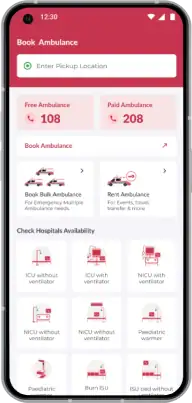Emergency medical services (EMS) play a vital role in saving lives during critical situations. In India, the landscape of EMS has undergone significant transformations over the years. However, challenges persist and there is a pressing need to assess the present state and explore the future prospects of EMS in the country. This blog delves into the evolution, current state, challenges, innovations and future outlook for emergency medical services in India.
Historical Context of EMS in India
The historical context of emergency medical services (EMS) in India traces back to the mid-20th century. In the 1960s, the first organized pre-hospital care system was established in the form of "first-aid posts" in major cities. These posts provided basic medical assistance and transportation to hospitals. However, the concept of modern EMS gained prominence in the 1990s when advanced life support systems were introduced.
The establishment of the Centralized Accident and Trauma Services (CATS) marked a significant milestone in Indian EMS. CATS was launched in Delhi in 1991 as a dedicated emergency response service. It aimed to provide timely medical care to accident and trauma victims. CATS introduced well-equipped ambulances, trained paramedics and a centralized dispatch system, ensuring quick and efficient emergency response.
Over the years, CATS expanded its operations, covering a wider range of medical emergencies and becoming a model for other states. Today, CATS and other EMS providers in India play a crucial role in saving lives by providing swift medical assistance and transport to hospitals, contributing to the overall healthcare infrastructure and public safety in the country.
Present State of EMS in India
The present state of emergency medical services (EMS) in India reflects a mix of progress and challenges. Over the years, significant improvements have been made, with the establishment of dedicated ambulance services, helplines and training programs. Government initiatives like the National Ambulance Service (NAS) and the implementation of technology-driven systems have enhanced emergency response. However, issues like traffic congestion and lack of public awareness hinder timely response. Efforts are being made to address these gaps through capacity-building programs, collaborations with private sectors and the integration of technology. To achieve a robust EMS system, further investments, policy reforms and community engagement are essential to ensure prompt and effective emergency care across the country.
Key Issues and Challenges
Despite significant progress, several challenges hinder the optimal functioning of EMS in India. Insufficient funding and resources continue to plague the system, affecting ambulance availability and quality of care. Rural areas suffer from limited accessibility, leaving remote communities vulnerable during emergencies. Additionally, a shortage of skilled healthcare professionals specialized in emergency care poses a serious challenge. The absence of standardized protocols and guidelines further adds to the complexities faced by EMS providers.
Innovations and Promising Initiatives
India's emergency medical services (EMS) sector is witnessing exciting innovations and promising initiatives that are transforming healthcare delivery across the nation. With a focus on improving response times, enhancing patient care and optimizing resources, these advancements are revolutionizing the way emergencies are handled.
One notable innovation is the implementation of mobile medical units equipped with state-of-the-art technology and staffed by skilled healthcare professionals. These units bring emergency care closer to remote areas, ensuring timely medical assistance to underserved communities.
Additionally, the integration of artificial intelligence and data analytics is streamlining EMS operations. Predictive modeling helps in anticipating medical emergencies, optimizing resource allocation and reducing response times. This data-driven approach enables efficient decision-making and better coordination between emergency teams.
Also, the emergency medical technicians (EMTs) are playing a significant role in raising the present standards of EMS in India. These dedicated professionals undergo rigorous training to provide efficient pre-hospital care. By swiftly assessing patients, administering necessary treatments and effectively communicating with healthcare teams, emergency medical technicians ensure timely and appropriate medical interventions. Their expertise, commitment and ability to handle critical situations contribute to improved response times, enhanced patient outcomes and the overall elevation of emergency medical services in India. With their invaluable contributions, EMTs are driving positive changes and setting higher standards for emergency healthcare across the nation.
Moreover, public-private partnerships are flourishing, facilitating the development of robust EMS networks. Collaborations between government bodies, hospitals and technology companies are improving infrastructure, training and resource management, resulting in enhanced emergency medical services nationwide.
These innovations and promising initiatives in EMS are propelling India towards a more efficient, accessible and patient-centric emergency healthcare system, saving lives and empowering communities across the country.
Future Outlook for EMS in India
The future outlook for emergency medical services (EMS) in India appears promising, driven by several key factors. First, there is an increasing recognition of the importance of a robust EMS system to address healthcare needs. Government initiatives and investments are being directed towards enhancing emergency response infrastructure, including ambulance services and helplines.
Technological advancements are also shaping the future of EMS in India. The adoption of telemedicine and mobile health solutions enables remote consultations and real-time medical guidance, enhancing the effectiveness of emergency care. Moreover, the integration of artificial intelligence and machine learning in EMS systems can aid in early diagnosis and efficient resource allocation.
Additionally, community awareness programs are promoting the importance of CPR training and first aid, empowering individuals to respond effectively during emergencies. This grassroots movement, coupled with improved public-private partnerships, will contribute to a more comprehensive and timely emergency response network across the country.
As India continues to prioritize healthcare accessibility, the future of EMS holds tremendous potential to save lives and reduce the burden on hospitals, ensuring better overall healthcare outcomes for the population.
Conclusion
In conclusion, the present and future of emergency medical services (EMS) in India holds immense potential for growth and development. The demand for quality healthcare services and efficient emergency response continues to rise, prompting advancements in the EMS sector.
As for MedCab, an emerging emergency and non-emergency ambulance service provider in India, it is well-positioned to capitalize on this evolving landscape. By leveraging modern technologies, maintaining a skilled medical staff and ensuring swift response times, MedCab has established itself as a reliable and trusted service provider. With a customer-centric approach and a commitment to delivering excellent medical care during critical moments, MedCab takes the opportunity to make a significant impact in the Indian EMS market and contribute to saving lives across the nation.






